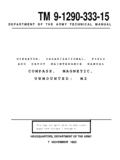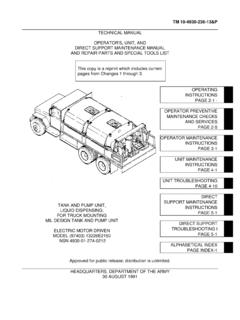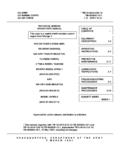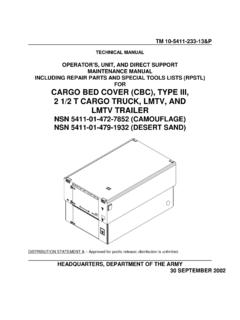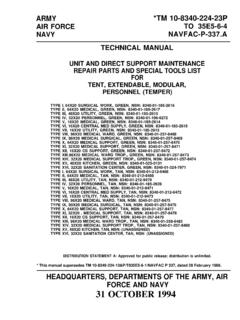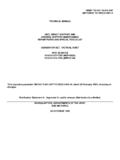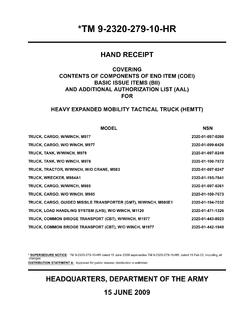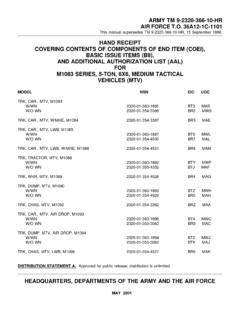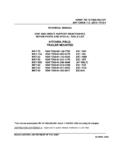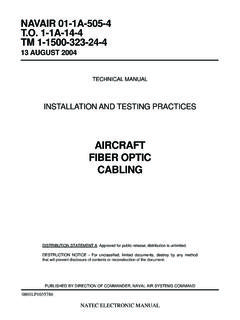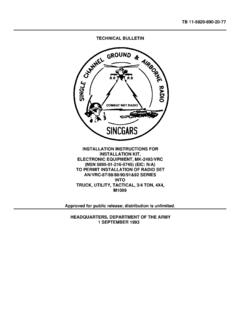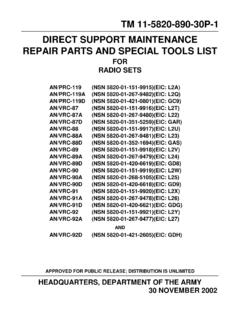Transcription of TM 11-5820-890-10-2 SINCGARS ICOM GROUND …
1 TM 11-5820-890-10-2 SINCGARS icom GROUND RADIOOPERATOR S pocket GUIDERADIO SETSOPERATOR ROADMAPMANPACK radio (NSN: N/A) (EIC:N/A)FLOW CHARTSVEHICULAR RADIOSI(AN/VRC-87A/C THRUJAMMING/ANTIJAMMINGAN/VRC-92A)(NSN: N/A) (EIC: N/A)TROUBLESHOOTINGCHECKLISTA pproved for public release; distribution is , Department of the Army1 SEPTEMBER 1992 SAFETY STEPS1DO NOT TRY TO PULL OR GRAB THE INDIVIDUAL2IF YOU CANNOT TURN OFF THE ELECTRICAL POWER. PULL, PUSH, OR LIFT THE PERSON TOSAFETY USING A DRY WOODEN POLE OR A DRY ROPE OR SOME OTHER FOR HELP AS SOON AS THE INJURED PERSON IS FREE OF CONTACT WITH THE SOURCE OF ELECTRICALSHOCK. MOVE THE PERSON A SHORT DISTANCE AWAY AND IMMEDIATELY START ARTIFICIAL RESPIRATION. REFER TO FM ENERGY IS PRESENT NEAR ANTENNA DURING TRANS- MISSION.
2 MAINTAIN AT LEAST 30 INCHES BETWEEN VEH- HICULAR ANTENNA AND PERSONNEL DURING TRANSMIS- VOLTAGEEXISTS AT CONNECTOR J1 ON VEHICULAR MOUNTING ADAPTER. AVOID PERSONAL INJURY:BE SURE J1 IS COVERED OR CAPPED WHEN NOT IN USEDEATH OR SERIOUS INJURY CAN RESULT: When antenna tip caps are not Installed on antennas. When a tied-down antenna hits a fixed object such as an overhead bridge, tree limb. Etc. Flying antenna parts might strike nearby OF CONTENTSSUBJECTPAGEF ront Panel ..3 Flow ChartsTASK 1 Single Channel Frequencies ..4 TASK 2 Local Fills ..6 TASK 3 Net Opening ..10 TASK 4 Communicate In FH 5 Maintain Net ..13 Jamming and Antijamming ..16 operator Troubleshooting Used ..23 Approved for public release; distribution Is pocket guide is intended for use by trained SINCGARS GROUND icom radio covers operator tasks and provides flow charts showing steps required to perform operator functions.
3 It serves as ahandy memory Jogger to help trained Operators follow required also provides guidance on how to respond to Jamming and an operator Troubleshooting more information Is needed, or when performing Pre-Mission Checks, refer to the operator s Manual ( tm 11 - 5820 -890-10-1).This manual supersedes TM 11-5820-890-10-2 , dated 1 March 19881RT FRONT PANEL23 FLOW CHARTTASK 1: SC FREQUENCIESTASK 1-1 ACTIONSRESULTSLOAD:(1) Get;(When desig-MAN CUE* orFrequenciesnated by com-SC frequenciesfrom SOI ormander)NCSNote ( STO Xand "XXXXXI ndicate num-bers obtainedfrom NCS orSOl)Set:COMSEC to PTMODE to SCFCTN to Z-FHDisplay shows"GOOD (orcontact unitmaintenance)FCTN to LDCHAN to or 1 thru 64 FLOW CHART5 FLOW CHART6 FLOW CHART7 FLOW CHART8 FLOW CHART9 FLOW CHART** Your own primary net Is normally stored In CHAN entering other nets, use CHAN 2 - 6 as CHART11 FLOW CHART12 FLOW CHART13 FLOW CHART14 FLOW CHART15 JAMMING AND ANTIJAMMINGJAMMING.
4 Jamming is the intentional transmission of signals that interrupt your ability to receive needed is the accidental transmission of signals that also interrupt your ability to receive needed signals If you arebeing jammed. it might sound like strong static, misleading signals, or random noise: or the net may be quiet with nosignals heard. These signals depend upon the type of jamming signals and whether your net is operating in single channel(SC) or frequency hopping (FH) mode The source of jamming could be power generators, radar sets, high power RF radiosets, or intentional enemy CHANNEL marker is lit(1) You have a bad(1) Try to free-upand showing a sig-handset if you dis-the stuck mike bynal higher than the hand-pressing push-to-You hear no trafficset and the lightedtalk 2 or 3 timesor noise and yousignal goes awayRemove faultyare not transmit-(stuck or "hot"handset and )with one that is good(2) You are being(2)
5 Change yourjammed If you settactical FCTN switch toTry to mask yourSQ OFF and hearRT/antenna bystrong static orplacing hills rocksrandom noise Youbuildings, etc, be-can confirm this bytween you and thedisconnecting theenemy. Notify yourantenna (MP) orsupervisor and pre-antenna cable (ve-pare a MIJI feederhicular) The will dropand the noise will goaway or be CHANNEL OPERATION. ContinuedSYMPTOMPOSSIBILITIESACTION(3) You may have(3) Set RT FCTN faulty or "locked-switch to STBY:up- RT If you try re-then to SQ ON. Ifmoving the anten-the problem stillna (MP) or antennaexists. contact unitcable (vehicular) the SIG markerremains higherthan marker Is litYou have enemy orSet RT FCTN to SQand showing a sig-friendly radio Inter-OFF and listen fornal higher than traffic. Try toYou hear randomidentify a friendlyradio traffic or ra-call sign If you candio signalsdetermine friendlysignals.
6 If you de-termine that Jam-ming Is from an locationand use terrain tomask your RT fromenemy jammingsource. Switch to abetter antenna (ifusing a to a vehicu-lar or OE-254).Contact NCS andyour supervisor17 JAMMING AND ANTIJAMMING ContinuedSINGLE CHANNEL OPERATION. ContinuedSYMPTOMPOSSIBILITIESACTIONSIG marker Is lit(1) You may have(1) Set RT FCTN toand showing a sig-enemy sweep jam-SQ OFF. You maynal higher than a very high-The SIG markerpitched noise ormay light on and offstatic each timeat regular Intervalsthe marker lights.(pulsing) or In aUse terrain to maskrandom cycle. Youyour RT from themay or may notenemy s sus-hear any locationContact NCS andyour supervisor.(2) You may have(2) Symptoms orradio or radar In-actions are sweep jamming(above) exceptthat signals will becoming from afriendly source(maybe).
7 Use ter-rain to mask yourRT from suspectedsource locationContact NCS andyour supervisor18 FREQUENCY HOPPING marker is lit(1) You are being(1) Reconnect theand showing a sig-jammed if you dis-antenna. Use ter-nal higher than LOconnect the anten-rain to mask yourThe signal markerna (MP) or antennaRT from the sus-may light on and offcable (vehicular)pected enemy lo-at regular intervalsand the SIG markercation. Contact(pulsing) or lightIs reduced or dropsNCS and your su-steady. There isto LO and the static whenIs attempt tohear net traffic.(2) You may be -receiving interference (2) If possible, obtainfrom a nearbyauthorizationhigh-power to have the interferingcommunication systemequipment(this Is a co-siteturned off (this de-problem).termines If you arereceiving Interfer-ence or If you arebeing jammed bythe enemy).
8 Moveaway from thesource of Interfer-ence by using ter-rain to mask yourRT from thesource. Attempt toremotely locateyour antenna(s) orRTs, separatingantennas by atleast 50 metersUse one RT at AND ANTIJAMMING ContinuedFREQUENCY HOPPING OPERATION. ContinuedSYMPTOMPOSSIBILITIESACTIONSIG marker is lit(1) There is a com-(1) Press handsetand showing a sig-promised or cap-push-to-talk 2nal higher than LOtured RT In yourtimes. If voice orYou hear a con-net. The compro-data transmissionsstart hiss or back-mised RT is con-return, continue toground noise In thestantly transmittingoperate. Contacthandset, but noto act as a Jam-NCS or refer toreal noise or Use procedures(2) There is a stuck(2) Push handsetmike or bad hand-push-to-talk 2set in your net thattimes. ContactIs locked. In theNCS Use authen-transmit (push-to-tication proce-talk) positiondures.
9 (3) Your RT has a(3) Disconnectstuck handset ifhandset from RTyou blow or speakand the SIG markerinto the mike anddrops to LO or be-you hear sidetonelow. Press handsetpush-to-talk sev-eral times to freethe switch If youreconnect thehandset and theSIG marker the badhandset with onethat is HOPPING OPERATION. ContinuedSYMPTOMPOSSIBILITIESACTIONYour net is not in aYour RT is out ofAttempt to contactsilence directiveFH sync or anotherand you haven tmember 2 or 3heard traffic for atimes. If unsucces-period of , perform pas-sive late net late net entry Isunsuccessful, per-form CUE and ERFprocedure. FollowNCS marker steadi-Co-site interfer-If possible, ask thely flikers. You canence from anotherinterfering radiocommunicate, to standthere is back-by or to reduce RFground popping orpower.
10 Attempt tostatic when you aremove your RT orreceiving. You no-antenna 50 meterstice your RT corn-or more. Contactmunication range : When a station in PT calls one In CT, the receiving operator can hear the message and beeping In the tells the receiving operator that the sender has COMSEC set to PT rather than S TROUBLESHOOTING CHECKLISTIf you have difficulty communicating, take the time to perform the following checks before you decide that there issomething wrong with your radio . Make sure you have all the switches set properly. Check all cable connections to ensure that they are tight. Make sure that the antenna is properly connected and positioned. Try to verify that you have LOS with other stations. Change position to see if communications improve. If you have not heard net traffic in some time, perform passive late net entry.
